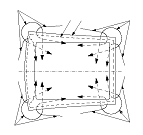-
With a helper on the outside, pull the piano wire (A) back and forth in a sawing motion. Hold the piano wire as close to the roof glass (B) as possible to prevent damage to the body. Carefully cut through the rubber dam and adhesive (C) around the entire roof glass.
-
Carefully remove the roof glass.
-
With a knife, scrape the old adhesive smooth to a thickness of about 2 mm (0.08 in.) on the bonding surface around the entire roof glass opening flange:
-
Do not scrape down to the painted surface of the body; damage piano will interface with proper bonding.
-
Remove the clips, fasteners, and rubber dams from the body.
-
Clean the body bonding surface with a sponge dampened in alcohol. After cleaning, keep oil, grease and water from getting on the clean surface.
-
If the old roof glass will be reinstalled, use a putty knife to scrape off all of the old adhesive, and fasteners and the rubber dams from the roof glass. Clean the inside face and the edge of the roof glass with alcohol where new adhesive is to be applied. Make sure the bonding surface is kept free of water, oil and grease.
|
Cutting portions

|